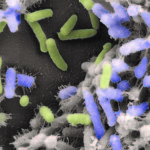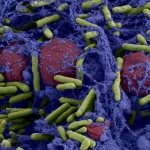Lien DOI – 10.1128/mBio.00729-20
mBio May/June 2020 Vol.11(3): e00729-20
Bacteroides thetaiotaomicron is one of the most abundant gut symbiont species, whose contribution to host health through its ability to degrade dietary polysaccharides and mature the immune system is under intense scrutiny. In con- trast, adhesion and biofilm formation, which are potentially involved in gut coloniza- tion and microbiota structure and stability, have hardly been investigated in this in- testinal bacterium. To uncover B. thetaiotaomicron biofilm-related functions, we performed a transposon mutagenesis in the poorly biofilm-forming reference strain VPI-5482 and showed that capsule 4, one of the eight B. thetaiotaomicron capsules, hinders biofilm formation. We then showed that the production of capsules 1, 2, 3, 5, and 6 also inhibits biofilm formation and that decreased capsulation of the popu- lation correlated with increased biofilm formation, suggesting that capsules could be masking adhesive surface structures. In contrast, we showed that capsule 8 dis- played intrinsic adhesive properties. Finally, we demonstrated that BT2934, the wzx homolog of the B. thetaiotaomicron glycosylation locus, competes with capsule production and impacts its adhesion capacity. This study therefore establishes B. thetaiotaomicron capsule regulation as a major determinant of B. thetaiotaomi- cron biofilm formation, providing new insights into how modulation of different B. thetaiotaomicron surface structures affects in vitro biofilm formation.
I M P O R T A N C E The human gut harbors a complex bacterial community that plays important roles in host health and disease, including nutrient acquisition, maturation of the immune system, and resistance to infections. The capacity to adhere to sur- faces and form communities called biofilms is believed to be important for niche colonization and maintenance of gut bacteria. However, little is known about the adhesion capacity of most gut bacteria. In this study, we investigated biofilm forma- tion in Bacteroides thetaiotaomicron, one of the most abundant bacteria of the nor- mal mammalian intestine. We identified that B. thetaiotaomicron capsules, a group of eight surface-exposed polysaccharidic layers mediating important interactions with the gut environment, are also major determinants of biofilm formation that mask or unmask adhesion factors. Studying how B. thetaiotaomicron regulates its adhesion properties will allow us to better understand the physiology and specific properties of this important gut symbiont within anaerobic biofilms.




